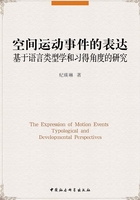
1.2 SPACE IN LANGUAGE DEVELOPMENT
The fact that speakers of different languages differ significantly in expressing motion events, despite an underlying common set of semantic components, raises a fundamental question for first language acquisition: will children follow adults in their own language and express motion events in a language-specific way from an early age on, or will their development follow universal cognitive determinants, resulting in similar expression of motion events irrespective of language?The debate regarding universal versus language-specific influences on language acquisition is not a newly arising topic.However, the discussion of this topic in the domain of space is especially meaningful.Given that space is fundamentally a cognitive domain and that there is some clear evidence for the universality of spatial notions which have evolved independently of language, any evidence of the impact of language on development will be of particularly striking significance.
Until recently, most researchers endorsed the predominating role of cognitive determinants in children's acquisition of spatial reference (as in a review by Bowerman 1994 and Hickmann 2006).According to this view, children are guided from the outset by a uniform set of spatial concepts which has evolved during the sensorimotor period of development, and children's early grammar can be characterized as directly mapping spatial terms onto language-independent concepts of space.In this light, space should be a domain where we are least likely to find cross-linguistic variations because our understanding of spatial relations is mainly based on a universal image schema that has a kinaesthetic basis and can be traced back to bodily experiences of the world (Johnson 1987).This ‘nativism’ view is deeply rooted in western philosophy and it has long been held in the psychology of language that “human spatial language is a direct reflection of our egocentric, anthropomorphic and relativistic spatial concepts” (Levinson 2003: 10).As far as language acquisition is concerned, the nativist idea is most clearly expounded by H.H.Clark (1973), as below:
The child acquires English expressions for space and time by learning how to apply these expressions to the a priori knowledge he has about space and time.This a priori knowledge is separate from language itself...[it] is dependent on man's biological endowment-that he has two eyes, ears, etc., that he stands upright, and so on-and in this sense it is innate (ibid.: 28).
Viewed this way, acquiring spatial language is a fairly straightforward process of “mapping local words onto antecedent concepts” (Levinson 2003: 14), and children irrespective of language and culture are thus expected to report motion events in a similar way.
However, recently more and more researchers have found that the process of mapping spatial language onto pre-linguistic cognitive concepts is not as direct as envisioned in the‘nativism’ view.In fact, when a particular spatial event is linguistically represented, it seems implausible to imagine that a specific language with its own grammatical categories and semantic distinctions exerts no influence at all on the way that these spatial meanings are organized.Slobin's (1996a) proposal of learning to “think for speaking” addresses this concern.He points out that each language provides a specific set of grammatical morphemes for schematizing motion experience for the purpose of verbal expression (e.g.verb particles and prepositions in English to express Path).“It is through listening that children's attention is first drawn to the fact that certain notions are grammatically marked in the ambient language...and the form in which one receives information from others influences how that information is understood, stored and later accessed” (Slobin ibid.: 94).In this light, a native language we learn in childhood “is not a neutral coding system of an objective reality”, but instead is a system that has trained its speakers from early on to pay attention to specific aspects of motion events and experience when talking about them (Slobin ibid.: 89).Therefore, “in acquiring a native language, the child learns particular ways of thinking for speaking” (Slobin ibid.: 76).According to this ‘language-specificity’ view, one can hardly expect that English and Chinese children will similarly describe their motion experiences.Instead, English children need to learn that path information is expressed through verb particles which need to be combined with verbs encoding various types of manner information in order to produce a complete representation of motion events.That is, they need to know from an early age that a motion event is characteristically packaged in their native language via the Manner verb + Path satellite combination (e.g.climb up ).By contrast, Chinese young children need to learn that a motion event is typically expressed in their native language by a verb compound in which all semantic aspects regarding a motion event are encoded in sequentially ordered constituent verbs (e.g. pa2-shang4 ‘climb-ascend’).
On the basis of the above discussion, it is important and meaningful to look into the domain of space from an acquisitional point of view.We will investigate the description of motion events by Chinese children at different age levels and compare them with the production of English children at the same age levels in order to reveal which factor has a larger role to play in children's spatial language development.Specifically, we shall explore to what extent children's development is constrained by a set of more or less universal cognitive factors and to what extent children actually follow a language-specific way of encoding motion events.It is also worth noting that the acquisitional study of spatial language may have broad implications for the general relationship between language and thought.If language-specific influences predominate in children's acquisition of the expression of motion events, then it will at least partially revive the Whorfian hypothesis of linguistic relativity and may further shed fresh light on how and when the language system influences other cognitive systems.